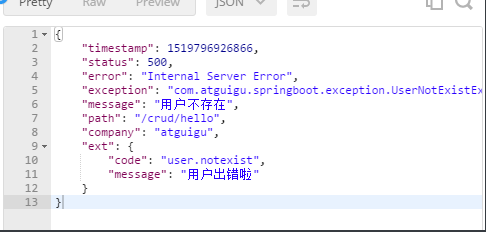SpringBoot預設的錯誤處理機制 即我們常見的白色的ErrorPage頁面 瀏覽器發送的請求頭: 如果是其他的請求方式,比如客戶端,則相應一個json數據: 原理;是通過 ErrorMvcAutoConfiguration,錯誤處理的自動配置; 給容器中添加了以下組件 1、DefaultErr ...
瀏覽器發送的請求頭:

如果是其他的請求方式,比如客戶端,則相應一個json數據:


原理;是通過
幫我們在頁面共用信息; @Override public Map<String, Object> getErrorAttributes(RequestAttributes requestAttributes, boolean includeStackTrace) { Map<String, Object> errorAttributes = new LinkedHashMap<String, Object>(); errorAttributes.put("timestamp", new Date()); addStatus(errorAttributes, requestAttributes); addErrorDetails(errorAttributes, requestAttributes, includeStackTrace); addPath(errorAttributes, requestAttributes); return errorAttributes; }
@Controller @RequestMapping("${server.error.path:${error.path:/error}}") public class BasicErrorController extends AbstractErrorController { @RequestMapping(produces = "text/html")//產生html類型的數據;瀏覽器發送的請求來到這個方法處理 public ModelAndView errorHtml(HttpServletRequest request, HttpServletResponse response) { HttpStatus status = getStatus(request); Map<String, Object> model = Collections.unmodifiableMap(getErrorAttributes( request, isIncludeStackTrace(request, MediaType.TEXT_HTML))); response.setStatus(status.value()); //去哪個頁面作為錯誤頁面;包含頁面地址和頁面內容 ModelAndView modelAndView = resolveErrorView(request, response, status, model); return (modelAndView == null ? new ModelAndView("error", model) : modelAndView); } @RequestMapping @ResponseBody //產生json數據,其他客戶端來到這個方法處理; public ResponseEntity<Map<String, Object>> error(HttpServletRequest request) { Map<String, Object> body = getErrorAttributes(request, isIncludeStackTrace(request, MediaType.ALL)); HttpStatus status = getStatus(request); return new ResponseEntity<Map<String, Object>>(body, status); }
@Value("${error.path:/error}")
private String path = "/error"; 系統出現錯誤以後來到error請求進行處理;(web.xml註冊的錯誤頁面規則)
@Override public ModelAndView resolveErrorView(HttpServletRequest request, HttpStatus status, Map<String, Object> model) { ModelAndView modelAndView = resolve(String.valueOf(status), model); if (modelAndView == null && SERIES_VIEWS.containsKey(status.series())) { modelAndView = resolve(SERIES_VIEWS.get(status.series()), model); } return modelAndView; } private ModelAndView resolve(String viewName, Map<String, Object> model) { //預設SpringBoot可以去找到一個頁面? error/404 String errorViewName = "error/" + viewName; //模板引擎可以解析這個頁面地址就用模板引擎解析 TemplateAvailabilityProvider provider = this.templateAvailabilityProviders .getProvider(errorViewName, this.applicationContext); if (provider != null) { //模板引擎可用的情況下返回到errorViewName指定的視圖地址 return new ModelAndView(errorViewName, model); } //模板引擎不可用,就在靜態資源文件夾下找errorViewName對應的頁面 error/404.html return resolveResource(errorViewName, model); }
一但系統出現4xx或者5xx之類的錯誤;ErrorPageCustomizer就會生效(定製錯誤的響應規則);就會來到/error請求;就會被BasicErrorController處理;
protected ModelAndView resolveErrorView(HttpServletRequest request, HttpServletResponse response, HttpStatus status, Map<String, Object> model) { //所有的ErrorViewResolver得到ModelAndView for (ErrorViewResolver resolver : this.errorViewResolvers) { ModelAndView modelAndView = resolver.resolveErrorView(request, status, model); if (modelAndView != null) { return modelAndView; } } return null; }
我們可以使用4xx和5xx作為錯誤頁面的文件名來匹配這種類型的所有錯誤,精確優先(優先尋找精確的狀態碼.html);
頁面能獲取的信息;
timestamp:時間戳
status:狀態碼
error:錯誤提示
exception:異常對象
message:異常消息
errors:JSR303數據校驗的錯誤都在這裡
2)、沒有模板引擎(模板引擎找不到這個錯誤頁面),靜態資源文件夾下找;
3)、以上都沒有錯誤頁面,就是預設來到SpringBoot預設的錯誤提示頁面;
如何定製錯誤的json數據;
Controller.MyExceptionHandler
package com.project.javasystem.Controller; import com.project.javasystem.exception.UserNotExistException; import org.springframework.http.HttpRequest; import org.springframework.web.bind.annotation.ControllerAdvice; import org.springframework.web.bind.annotation.ExceptionHandler; import org.springframework.web.bind.annotation.ResponseBody; import javax.servlet.http.HttpServletRequest; import java.util.HashMap; import java.util.Map; @ControllerAdvice public class MyExceptionHandler { //方法一: //瀏覽器,客戶端都返回的是Json數據 /* @ResponseBody//響應json數據 @ExceptionHandler(UserNotExistException.class) public Map<String,Object> handleException(Exception e){ Map<String,Object>map = new HashMap<>(); map.put("code:","User.notExit"); map.put("message:",e.getMessage()); return map; }*/ //方法二:自適應效果 @ExceptionHandler(UserNotExistException.class) public String handleException(Exception e,HttpServletRequest request){ Map<String,Object>map = new HashMap<>(); //傳入自定義的狀態碼 /*Integer statusCode = (Integer)request.getAttribute("javax.servlet.error.status_code");*/ request.setAttribute("javax.servlet.error.status_code",500); map.put("code:","User.NotExit"); map.put("message:","用戶出錯啦"); //轉發到error進行自適應處理 request.setAttribute("MyError",map); //轉發到error return "forward:/error"; } }
出現錯誤以後,會來到/error請求,會被BasicErrorController處理,響應出去可以獲取的數據是由getErrorAttributes得到的(是AbstractErrorController(ErrorController)規定的方法);
1、完全來編寫一個ErrorController的實現類【或者是編寫AbstractErrorController的子類】,放在容器中;
2、頁面上能用的數據,或者是json返回能用的數據都是通過errorAttributes.getErrorAttributes得到;
容器中DefaultErrorAttributes.getErrorAttributes();預設進行數據處理的;
自定義ErrorAttributes
Component.MyErrorAttributes
package com.project.javasystem.Component; import org.springframework.boot.web.servlet.error.DefaultErrorAttributes; import org.springframework.stereotype.Component; import org.springframework.web.context.request.WebRequest; import java.util.Map; @Component public class MyErrorAttributes extends DefaultErrorAttributes { //返回值 map中就是頁面和json能獲取的所有欄位 @Override public Map<String, Object> getErrorAttributes(WebRequest webRequest, boolean includeStackTrace) { Map<String, Object> map = super.getErrorAttributes(webRequest,includeStackTrace); map.put("CompanyName","517NA"); // 異常處理器攜帶的數據 Map<String,Object>MyError = (Map<String, Object>) webRequest.getAttribute("MyError", 0); map.put("MyError",MyError); return map; } }
最終的效果:響應是自適應的,可以通過定製ErrorAttributes改變需要返回的內容,





